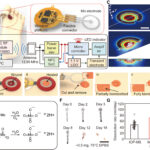2023-02-23 スイス連邦工科大学チューリッヒ校(ETHZurich)
◆チューリッヒ工科大学の毒物学教授であるシャナ・スターラ(Shana Sturla)博士が率いる研究チームは、この新しい手法によって、タバコの煙と肺がんとの関係を初めて明らかにしましたが、この過程でどのDNA構成要素が変化したかを正確に特定することができたのは、今回が初めてとなります。この方法を使えば、いつの日か他の毒物の細胞に対する影響も調べることができるようになるはずである。これまで、このような毒性学的研究は実験動物を使って行わなければならなかった。
◆今回、研究者らは、『External pageACS Central Sciencecall_made』誌に発表された研究の中で、ベンゾピレンという特定の化合物に着目した。この化合物は、タバコが燃やされたときに生成される。この化合物が人体に入ると、非常に特殊な代謝物に変換され、その毒性は長い間知られていた。科学者たちは、このベンゾピレンの代謝産物を、研究室で培養した肺の細胞に加え、研究を行った。
<関連情報>
- https://ethz.ch/en/news-and-events/eth-news/news/2023/02/where-do-toxins-from-tobacco-attack-dna.html
- https://pubs.acs.org/doi/10.1021/acscentsci.2c01100
ヒトゲノムにおけるアルキル化の定量化とマッピングにより、変異シグネチャーの1塩基分解能の前駆体が明らかになった Quantification and Mapping of Alkylation in the Human Genome Reveal Single Nucleotide Resolution Precursors of Mutational Signatures
Yang Jiang, Cécile Mingard, Sabrina M. Huber, Vakil Takhaveev, Maureen McKeague, Seiichiro Kizaki, Mirjam Schneider, Nathalie Ziegler, Vera Hürlimann, Julia Hoeng, Nicolas Sierro, Nikolai V. Ivanov and Shana J. Sturla
ACS Central Science Published:February 22, 2023
DOI:https://doi.org/10.1021/acscentsci.2c01100

Abstract
Chemical modifications to DNA bases, including DNA adducts arising from reactions with electrophilic chemicals, are well-known to impact cell growth, miscode during replication, and influence disease etiology. However, knowledge of how genomic sequences and structures influence the accumulation of alkylated DNA bases is not broadly characterized with high resolution, nor have these patterns been linked with overall quantities of modified bases in the genome. For benzo(a) pyrene (BaP), a ubiquitous environmental carcinogen, we developed a single-nucleotide resolution damage sequencing method to map in a human lung cell line the main mutagenic adduct arising from BaP. Furthermore, we combined this analysis with quantitative mass spectrometry to evaluate the dose–response profile of adduct formation. By comparing damage abundance with DNase hypersensitive sites, transcription levels, and other genome annotation data, we found that although overall adduct levels rose with increasing chemical exposure concentration, genomic distribution patterns consistently correlated with chromatin state and transcriptional status. Moreover, due to the single nucleotide resolution characteristics of this DNA damage map, we could determine preferred DNA triad sequence contexts for alkylation accumulation, revealing a characteristic DNA damage signature. This new BaP damage signature had a profile highly similar to mutational signatures identified previously in lung cancer genomes from smokers. Thus, these data provide insight on how genomic features shape the accumulation of alkylation products in the genome and predictive strategies for linking single-nucleotide resolution in vitro damage maps with human cancer mutations.


